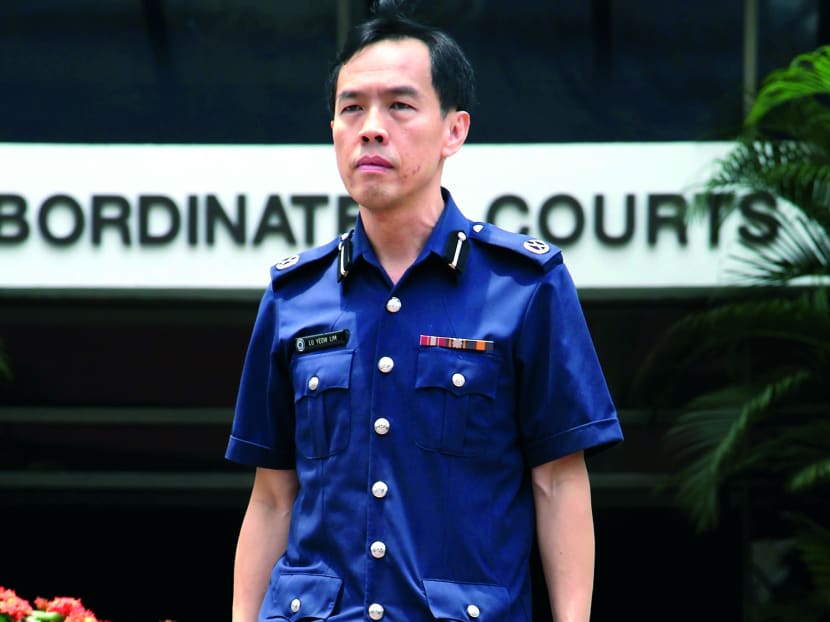Police commander comes under fire for ‘staying put and doing nothing’ during riot
SINGAPORE — For roughly half an hour after arriving at the scene of the Little India riot, the police commander overseeing operations to quell the melee chose to keep a distance from the mob, calling for backup, while his men shielded him from projectiles hurled by rioters.

Tanglin Police Division commander Lu Yeow Lim at the Subordinate Courts during the Little India Committee of Inquiry, 04 Mar 2014. Photo: Don Wong
SINGAPORE — For roughly half an hour after arriving at the scene of the Little India riot, the police commander overseeing operations to quell the melee chose to keep a distance from the mob, calling for backup, while his men shielded him from projectiles hurled by rioters.
Deputy Assistant Commissioner (DAC) Lu Yeow Lim’s decision not to move in on the crowd despite being attacked came under fire yesterday, with the Committee of Inquiry (COI) Chairman lambasting him for “(staying) put at a protected place and (doing) nothing”.
The lengthy questioning DAC Lu was put through yesterday on how he conducted operations that night continued a scrutiny of police actions since the COI began. Other officers who had taken the stand earlier were grilled on whether rioters were emboldened by the sight of police officers running away from the epicentre of the fracas, among other things.
In a series of testy exchanges yesterday, the COI pressed DAC Lu, who is commander of Tanglin Police Division, on various issues, including whether his sole strategy that night was to wait for the Special Operations Command (SOC) troops to arrive.
COI member Tee Tua Ba, a former police commissioner, said: “You were waiting for half an hour ... Five minutes is a long time during a crisis.”
DAC Lu defended his call, saying it was too risky to engage the mob when the officers at the scene were grossly outnumbered: “I explained to the Deputy Commissioner of Police that I would hold the position until the SOC arrived. I was not going to yield this position. If they had come to attack me, that would be a different proposition.”
His response earned a swift retort from Mr Tee, who pointed out that “they (were) already attacking you”.
However, DAC Lu countered that the crowd was pelting officers from a distance and they could not see clearly who the culprits were.
“This is not a case where you had two armies squaring off. It was fighting an insurgency. They are embedded within civilians. You don’t have a clear line of sight on who was attacking you,” he said.
“You run the risk of killing innocent people. You could’ve shot a police officer. It would be a different COI — ‘Why did you act rashly, why were you trigger happy?’”
He added that his guiding principle that night was to “not use force unless there was no choice”.
“If we had opened fire and shot or killed one of them, the sentiments would have been inflamed. They (the rioters) might have set fire to a building or attacked people.”
DAC Lu was also asked to justify why he did not send any of the eight officers around him to round up those pelting objects at them or slip through the crowd — since he was not in uniform — for a better understanding of the situation.
He replied that the melee spanned “three football-size fields end to end”, with his officers “scattered all over the place”.
“What is the size of the forces available to you? I only had eight. There are trade-offs. If you think that we stand there and are risk averse, nothing could be further from the truth.”
DAC Lu added that police doctrine states that the commander of an incident should not enter the fray, because “if you are fighting the battle itself, getting into the tangle, you can’t command”.
He argued that the crowd knew who he was, although he was in plainclothes, because they rained projectiles on him each time he stepped out from under the shields.
However, COI Chairman G Pannir Selvam said: “You did not know (the situation on the ground) because you chose not to know.”
The COI members also cited the examples of the traffic police officer who had testified earlier during the inquiry and thrice charged solo at rioters that night to disperse them, and the six SOC troopers, who moved through the crowd without resistance, to challenge DAC Lu’s contention that the mob could have overwhelmed his officers and grabbed their weapons.
However, DAC Lu pointed out that the committee had the benefit of hindsight as well as the evidence gathered over three months.
“I read the crowd based on what I saw,” he said. “Looking at the level of violence, I had every reason to believe they would turn hostile.”
He added that once the COI fleshed out events of that night and the considerations the police had, the public could decide whether the police had acted rashly, conservatively or objectively.









